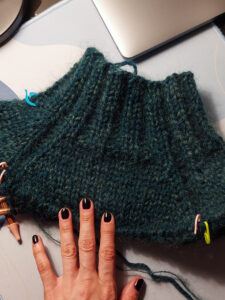Knitting - Increase Part
Cast on 6 stitches.
1st row – 10th row: this is just the i-cord part, so it will look a bit strange but for 10 rows we knit 3 stitches and slip last 3 stitches with yarn in the front.
1 row (right side): knit 3, yarn in front slip 3.
2 row (wrong side): knit 3, slip 3.
Repeat for 10 rows.
Pattern
Every increase is worked into the 4th stitch, i.e. right after 3 stitches of i-cord. I-cord consists of 3 stitches. I made all increases with knit into front and back loop approach (k1f&b). This means working into the same stitch more than once and knitting into the front leg then into the back leg of the same stitch. It looks best with garter stitch pattern.
This is the increase pattern:
Increase in every 11th row (repeat 9 times) This means we knit 10 rows, on the 11th row we make an increase, knit another 10 rows and on the 11th make and increase and repeat this rapport 9 times.
Increase in every 9th row (repeat 4 times) This means we knit 8 rows, on the 9th row we make an increase and repeat this rapport 4 times.
Increase in every 5th row (repeat 3 times) This means we knit 4 rows, on the 5th row we make an increase and repeat this rapport 3 times.
Increase in every 3rd row (repeat 3 times) This means we knit 2 rows, on the 3rd row we make an increase and repeat this rapport 3 times.
After all the increases there should be 26 stitches on the needle.













